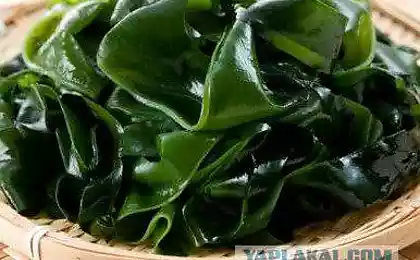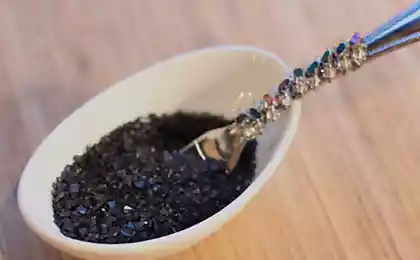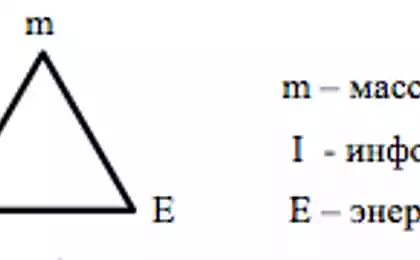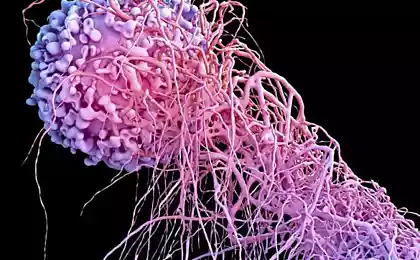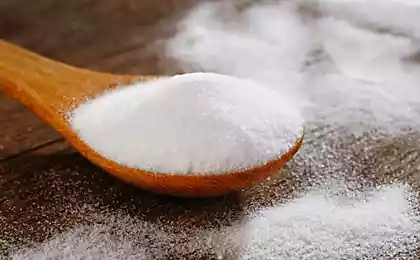847
Sea salt. Stereotypes, myths and chemical properties
What is different about sea salt and how water pollution affects the quality? Interesting chemical experiments and refutation of popular myths about the usefulness of sea salt.
The origin of sea salt and methods for its production:
In fact, by and large, all produced on the planet salt comes from sea water — it precipitates crystals of halite and it does not matter modern it is water or covered our planet millions of years ago. But the conventional divide still exists. Code Alimentarius treats salt as a crystalline product, consisting of at least 97% sodium chloride on dry matter (this is important), it is extracted from the sea, from underground salt mines and natural salt brines".
However, the efforts of modern marketers to sea salt, have already formed a whole set of stamps and spawned them on the basis of a modern mythology. I do understand that these myths, the reality, and that violet smoke. :)

Here is my current collection of salt, which is sold as "marine".
Top row left to right: Swedish pyramidal salt in cereals (1), grey salt (2) and a Fleur de salt (3) from Guérande (France)
Center left to right: Crimean pink salt (4), fine sea salt since (5), Dead sea salt from Israel (6).
Bottom row left to right: Hawaiian red (7) green salt (8), Fleur de salt lake Baskunchak (9), and sea salt for the bath was still the USSR (10).
How not to get lost in this diversity and choose what really is a natural product, and what can be quoted?
Let's deal.
But at the same time and look at the facts "utility", "natural" and other sustainable cliches that are full of pseudo-scientific and okolofutbolnye articles about sea salt. :)
I. the FIRST MYTH
Sea salt — natural origin or the economy must be economical.
Modern salt production are important, not the source, and the method of its production scale, technology, cost and every prosaic matter in the form of additional buns — get related minerals from waste products. And sometimes the salt itself acts as a waste by-product.
Certainly easier and cheaper to open formed millions of years ago underground or underwater salt dome to draw out the salt though harvesters, though pumps. And this salt, a stone extracted in the mine way or lake, samostojna is the above which have worked and are working today nature. Our task is to take and not to lose in the final product that already exists.
Method artificial crystallization of halite in the pools of sea water, and do it all marine fisheries, called "SADC salt" and is, in fact, the formation of salt crystals in certain conditions. I mean, Yes, natural factors are present — water, wind, wooden rake, clay soil, that's all. But most of the salt pans is a complex hydraulic structure, which also uses seasonal. Sea water is pumped by pumps multistage "salt ponds" with a complex system of flows and channels and passes through several stages of evaporation and salt concentration of brine purification from mechanical impurities and silt deposition related to the dissolved elements in the form of gypsum, dolomite, calcite, salts, etc. and only in the penultimate turn precipitates halite. All this complex basin agriculture requires care, remarkable skills of staff, and in some places, and does manual labor. The order of deposition of salts from the brine — is the important "secret" of each fishery, as it depends on the weather, climate and skill saline. And somewhere else it is necessary to put the remaining water and remaining minerals in it, which is better solubility of halite is borates, sulfates, magnesium and other table grandpa modern chemistry. (As far as I know, in the Crimea even operated a plant to produce liquid bromine and magnesium salts, which likely gave an extra penny Providence).
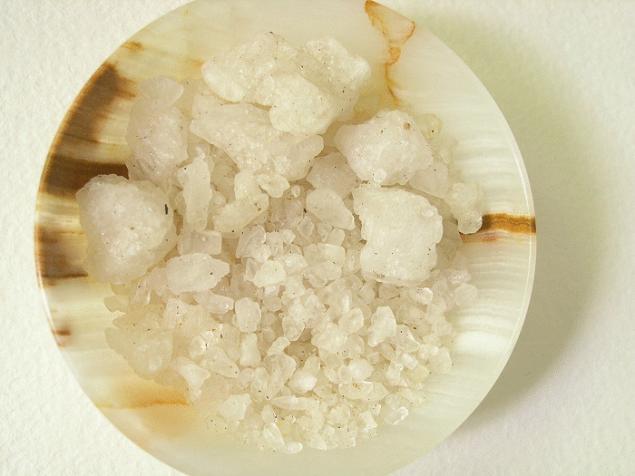
The photo is about like this get salt from sea water — a grain of sand, particles of clay and various other things which we come. So after the "harvest" halite undergoes several stages of maturation — cleaning now from the "ground" or "human" factor, flushing and drying. Where the production of sea salt by the way are large enough, separate the deposition is not used, the salt is simply harvested by combines and is subjected to cleaning (USA, Italy, Turkey, Cyprus). Or using modern technology — deep-water pumps, artificial pools under the eaves with adjustable air flow (hi). One or another of the salt subjected to the usual refining process — dissolution and crystallization in the vacuum apparatus.
And here is the first boundary of naturalness, that is to say "natural". Well, partly subjective, of course:
Salt, which precipitated from sea water and unless washed with concentrated brine, get in a few places. Salt:

Salt, which precipitated from sea water by using high-tech equipment or subjected to refining or modification. This salt
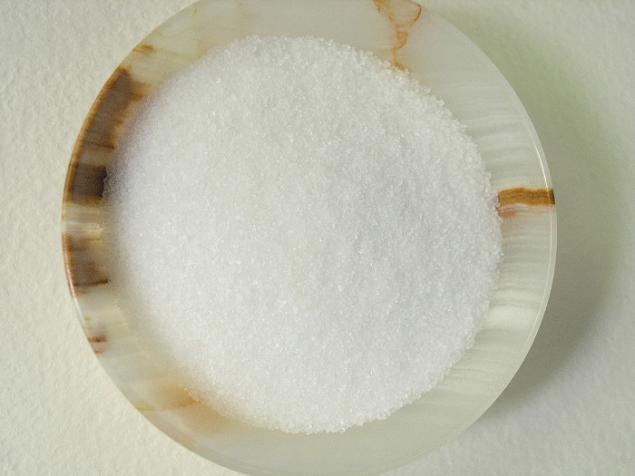
As global economies have long understood about sea salt handicraft or semi-handicraft production is unlikely to be a percentage of the total world production, since objectively, even for large producers costs much higher than for the extraction of stone or samostojni of salt, and the volume of production is much less. The higher costs in traditional businesses, where everything is old-fashioned methods and is maintained afloat thanks to tourism and practice "protection of traditional names."
Hence its elevated price that you need to justify.
About the trace minerals contained in sea salt, their benefits and dangers:
Even at the beach, I would like to clarify a couple of points that took as a starting point.
1. The prefix "macro" "micro" in relation to the chemical elements as constituents of food in recent years, rapidly replaced by the prefix "oligo-", which actually literally means "minor" and indicates the deviation from the norm in the direction of decreasing something.
Meanwhile, it is quite scientific terms, as explained to us encyclopedia. Macronutrients of food is contained in food chemicals, the daily demand which is not measured in less than tenths of a gram, is: Na, K, Ca, Mg, P, etc is two decimal places.
Trace elements nutritional elements contained foods in low concentrations and required for normal functioning. Metals (Al, Fe, si, Mn, Zn, Mo, Co, Ni, Sr, etc.) and nonmetals (I, Se, Br, F, As, At). They are usually measured in thousandths of a percent or less — is three or four decimal places.
Anything less than these numbers is the so-called "trace" amounts, i.e. at the limit of measurement accuracy to the existing methods.
2. Standards for salt (GOST), adopted in our country, can not distinguish sea salt from other, reducing the difference of the indicators only on the degree of purification. Plus sanitary regulations on the content of harmful substances. In fact the same standards apply throughout the world, differing only in details.
3. The data and figures I took with packages of salt, of certificates of the producers (decent manufacturers keep them in the public domain), and data analyses performed for producers and independent studies. Links — along the way.
So.
II. THE SECOND MYTH
Sea salt contains less sodium chloride and more iodine than "normal" salt.
Comparisons and experiments involved salt here from the first photo.
Here its characteristics.

Whether so it actually, can be seen from the table. According to the Code Alimentares that the salt has the prefix "food" it must contain not less than 97% sodium chloride in dry matter. All the salt that does not fit into this standard, is classified as agricultural (for animals) or technical (cosmetics, lamps and plates, etc.)
Here are the reservoirs of different size and different geographical location. It is obvious that the composition of the salt should be different. But actually this wide variety allows to distinguish only two groups — salt, industrial and traditional production method. First, we compare available indicators of industrial salt produced with the standard adopted in our country.

Perfectly clear that the content of sodium chloride salt corresponds to these marks of refined salt are of the highest quality, that is the most "normal" of salt, which in any case contains all the macronutrients and all in the same range. And this is understandable. Any industrial method of salt production involves cleaning it up one way or another, at the exit giving refined salt, normal quality, does not have any advantages over other types of salt. For example, the Israeli company's main activity is the production of chemical fertilizers and table salt is a byproduct. Besides the mineral composition of Dead sea water simply does not allow to directly obtain from it salt food quality.
If you look at the iodine... can You see him? So I do not see. Simply because of all the iodine compounds volatile and unstable, and by the time the salt is Packed in the bundles, they are safely apart. The existing in the sale of sea salt "iodized" is refined sea salt with added iodine. Iodine, by the way, added exclusively to refined salt simply because other macronutrients, which more unrefined salt is able to displace iodine from it potassium compounds — and in the end he will go out again.
And, as in any salt is fine, sea salt is added protivokashlevami component.
Thus, the content of microelements in the examined samples clearly demonstrates that the alleged "advantages" of sea salt commercial production tutsarena mist, and evaporating directly on the sea shore iodine. That is from the name "sea" is a sea water as its source.
An important indicator of natural sea salt and the evidence that salt was not processed — it figures 8 and 9. "Insoluble residue" is the impurities and "Moisture" is water built in the crystal lattice of the salt. About them later, when it will be, the subject of conversation, and yet the data we do not even hint at their presence.
And this fact tells us that all sea salt major manufacturers are no better than other types of salt — stone or evaporated, and thus the entire amount in excess of the normal prices we pay for marketing.
And again. As you wish, but these are mangled Latin words in the titles, in my opinion put brands on a par with "Panassonik", "Abibas" and similar artifacts.
OK. But, it may be, really has the advantage and is worth the money salt natural, mined manually in the traditional way?
At the same time will dispel another myth.
III. THE THIRD MYTH
Sea salt is a source of valuable minerals or deposits of precious stones and gold dust in the bowels of the body."
Take a look at another table, which compares with the standards of the marine raw salt, which is available for me at the moment.

What do we see here? Iodine is not present here, or it is in such small quantities, that does not even have preventive value. But has marketing. :) With their backs against the wall manufacturers and retailers reluctantly admit that the iodine content in their product so low, that their salt may not be recommended even as a preventive measure.
Speaking of macrominerals composition, we again see that natural sea salt does not go beyond the usual content of unrefined salt first and second grade, which, incidentally, include the majority of varieties of natural stone salt.
And what is it with trace minerals? Wanting to show how unique their products, some manufacturers and retailers order an independent study of their samples for the presence of trace minerals all existing physico-chemical methods.

In the lower part of the table looks at only those items in respect of which the maximum permissible concentration of them in foods and helps you understand what and how much. I did not give here the tails of the tables with the complete data, but the results of research are reflected 4/5 of the entire periodic table, including heavy metals, rare earth, transuranium, radioactive elements. In nature in pure form, they're not Dating, but are part of some minerals and sea water. All of them are in the samples in the so-called "trace" amounts, which is so proud of marketers of sea salt.
Why is important all this math? Part of this chemical compote — strong poisons to kill and have an impact immediately or after some time, having ability to accumulate in the body — it all depends on the dose. So strong mineral composition — controversial use, in my opinion...
However, the effect of trace elements is much weaker pronounced than the effect of macro-elements. And the most important here sodium. All the manufacturers of sea salt talk about lower the amount of sodium in sea salt. But if you add up the first two lines of the table, we almost always get the desired 97-98%. Only one salt Seltic Salt shows a decrease in the total score — 83%, but the reduction in sodium is not that big compared to the other. So the law of conservation of the same grandfather Mendeleyev, it contains more of something else. And that other — sulphides, carbonates, etc. little studied from the point of view of food values.
However, many say that sea salt is less salty than "regular" salt. That, incidentally, is a term that means nothing, if you understand. It is better to compare refined and unrefined salt. And then Yes, tasters of salt or a sensitive person can perceive the difference.
The fact that the water minerals kristallizuetsya mainly in the form of crystalline, and therefore there is no such figure as "the water content determines the content of bound water. Perhaps her presence in the crystal lattice due to the "less salty" taste unrefined sea salt, which I feel some.
The generally accepted standard prescribes that the content of sodium chloride should not be less than 97% of "dry matter". That is, for analysis of salts previously removed water, and then take measurements. In a natural salt trap, as the permit regulations may include, 4-5 even up to 12 percent water (France), so given more, and insoluble residue (impurities) is obtained less than 95% sodium chloride, and therefore, decreases the salty taste. However, in order to "fill in" familiar feeling, perhaps it would have just add more.
Once again — we are talking only about raw, natural sea salt trap. Every other has less water or does not contain it at all. Water sea salt is removed in different ways. Over millions of years in the earth's crust under enormous pressure, the processes of recrystallization, formation of new compounds, etc., so the composition of rock salt, for example, is quite different from the sea. Another natural process — the storage of salt in piles on the beach: rain, wind and sun also contribute to the chemical and physical transformations and removal of excess moisture from the salt. In large enterprises for the production of sea salt can't lose that much time to dry the salt in a natural way. Therefore, excess water is removed from it in any commercial way.
Whether such bound water in salts, helps to find a fairly simple physical experience. I took 30g of different salt and heated it in a dry, tightly sealed container in a sand bath for 10-15 minutes.
The rest of the heated salt no plaque on the foil is not given, it is quite adequate to the lack of moisture.
The fact that "when heated above 100°With," well, you know... give the Crystalline water, the water begins to evaporate, the carriage turns into a pumpkin and at 150°With sea salt loses all of its advertised properties.
But that's not all. There is another indicator of naturalness, which is also a good idea to cover. And it will be "insoluble residue", which is not present in refined salt which is in salt natural.

Picture after standing for several hours

Refined Dead sea salt predictably gave a completely clear solution
On the criteria of quality that distinguish salt:
IV. THE FOURTH MYTH
"Water — source of life" — the millions of bacteria can't be wrong.
Still we are all looking for favor, dissolved in sea water. But. There is another curious indicator is the insoluble residue. It's all kinds of contamination — natural or not. It is obvious that it will contain only unrefined salt, stone, or charging it doesn't matter. In order that the salt belonged to the category of food, this insoluble residue should be less than 1%.
To the category of insoluble residue are:
water — soluble compound, the "sitting down" with salt
— organic remains of marine flora and fauna, etc.
— silt, clay, sand, rocks
— oil, crumbs of metal or concrete, rust, etc.
On the Internet you can find a very beautiful romantic rose-red panorama of the salt pools. This "bloom" of salt water gives prosaic livelihoods around hundreds of types of so-called "halophilic" flora and fauna — are small crustaceans, algae and bacteria adapted to living in strong brines. The basis of their activity is not chlorophyll, and orange dye beta-carotene, which recently ranked as important antioxidants. In a certain way these products can be removed along with the salt, and then it acquires a pinkish-orange color, but such salt is not a food product and can be used in cosmetic products or as a source of beta-carotene.
And that's not all kinds of bacteria that exist in seawater — pathogenic rods and cocci quite survive in salt water at a concentration of 10-15% up to three months. And if the salt is not subjected to any thermal treatment above 70°C. They are quite comfortable to feel it in and waiting in the wings.
Since there are strict regulations on the content of bacteria in food products, each batch of French salts organic origin is biological control. For comparison, refined sea salt made in the USA passes such inspection once a year.
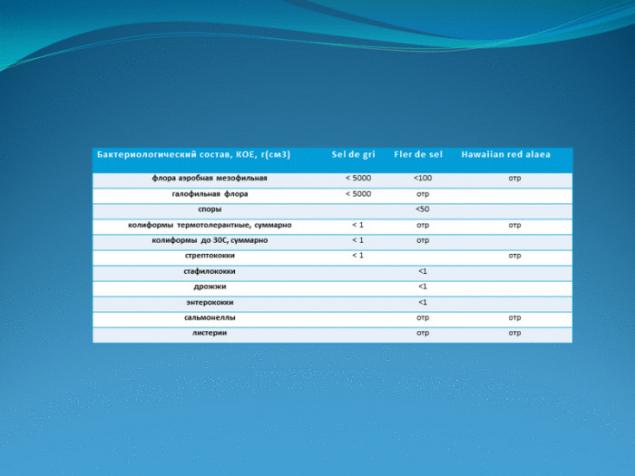
If the first three contamination can be attributed to the natural, then the fourth paragraph adds commercial production. That is why most of the charging sea salt is mined by open method, is subjected to a particular treatment.
Well, now take a closer look.
The presence of sediment to detect a breeze, and with that face all preparing, for example, brine for cucumbers. If you take unboiled cold water and stone, for example, salt.
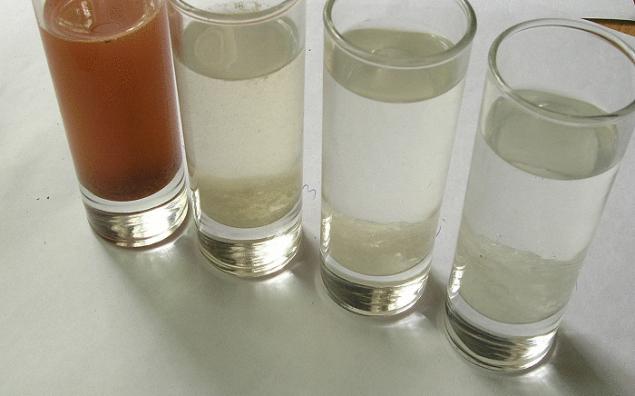
Left to right: red Hawaiian salt, grey salt, Crimean salt, Dead sea salt. The naked eye can see that the color of the solutions is slightly different.
However, red Hawaiian salt and black Cretan salt do not belong to natural salt, since they contain artificial additives: activated charcoal and purified red clay. I almost said, "clay food quality." :) Is to say that the initially turbid solution became more transparent through the day, in the process of settling both solutions were clear, almost everything they added, settled the same on the bottom. That is, no artificial tint of components, all natural mineral.

What can be said about a trendy "green Hawaiian salt". As additives it contains organic extract of green bamboo" made in China. The photo package out of this most fashionable of salt. In the process of storing a faint smell, of course, has long been eroded, and all that served as a carrier of the extract left a mark not only on the salt crystals, but also on environmentally friendly paper package. :)

As a result, let's compare what we eventually get on the shelves called "Sea salt". In fact, all the high-sounding trade names are the same two broad categories of salt — refined and unrefined. Each of them has its advantages and disadvantages that arise from their characteristics. published
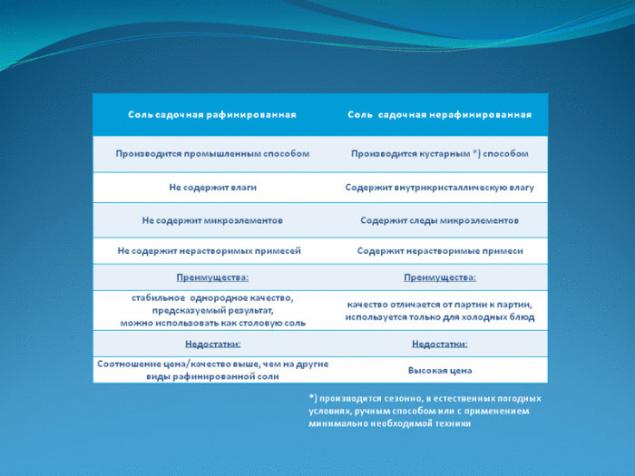
Author: Galina Gosteva
P. S. And remember, just changing your mind — together we change the world! ©
Source: www.livejournal.com/magazine/968292.html
Psychosomatic diseases: how to program children are our stereotypes of education
Here's how to make your own pool from 9 pallets



